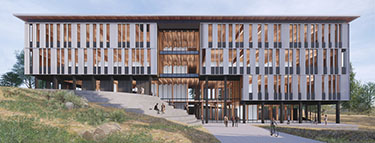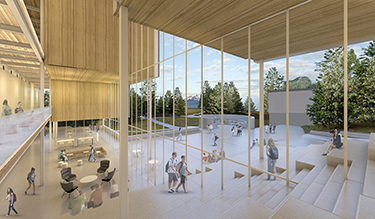|
Subscribe / Renew |
|
|
Contact Us |
|
| ► Subscribe to our Free Weekly Newsletter | |
| home | Welcome, sign in or click here to subscribe. | login |
Architecture & Engineering
| |
 |
October 3, 2019
New OSU-Cascades academic building will aim for net zero
SRG Partnership

Hampson
|
The unique high desert campus of Oregon State University-Cascades is growing and has recently begun the design process for the transformational new Academic Building 2.
After hosting a highly competitive design competition as a part of its overall design team procurement, the university selected SRG Partnership as its architect. The new 50,000-square-foot building will provide learning spaces for science, technology, engineering, arts and math, and will create a new student hub with active interior and exterior event and social activity spaces.
The design will elevate OSU-Cascades’ identity in Bend while exemplifying the university’s commitment to sustainability with a net-zero energy target and a structure of regionally sourced mass timber.
Academic Building 2 will also be the first building to engage a dramatic reclaimed pumice mine acquired by the university for future campus expansion. The building will be sited on the rim of the vast man-made chasm, providing panoramic views across the future west campus and to the mountains beyond. The building and its adjacent outdoor spaces will step with the topography to create a gateway and link between the existing upper campus and the future development that will occur below in the bowl of the transformed mine.
Mass timber structure
Taking cues from the unique geology of the site, the building will feature a dynamic indoor-outdoor environment to support numerous activities and events, engaging people through classroom, laboratory and maker spaces; a formal amphitheater and an informal cascading plaza will promote gathering.
Outdoor spaces will be a natural extension of the interior learning environments and will feature a diverse range of areas for casual gatherings, personal introspection, and open-air classes, lectures, and performances. The climate, native vegetation and ecosystems of Central Oregon will be reflected in the landscape approach and will be inspired by the natural and man-made forces which have shaped the surrounding terrain.
The selection of mass timber for the building’s structural system reinforces OSU-Cascades’ robust commitment to sustainability with the use of a locally sourced renewable material and the low-carbon footprint associated with its production. The natural beauty of the timber structure will be expressed in the building’s interior, creating a warm, inviting environment for students and faculty and visually connecting the building with the broader regional landscape.
The building’s primary facade will feature tall windows and a filigree of vertical shading devices tuned to their solar orientation to maximize daylighting and mitigate glare and summer heat gain. A broad horizontal roof plane floating above the mass of the building form has been designed to accommodate an array of photovoltaics, which will provide on-site renewable energy for the project. The building’s scale and use of natural materials will connect with the existing campus architecture while charting a path forward for future development.
An adaptable concept
The design solution also reflects OSU-Cascades’ goals of creating a scalable and adaptable concept that can serve as a model for future buildings. The team developed a simple building organization strategy with a flexible planning module and adaptable service core to support a variety of academic programs and functions. This concept can be adapted to the unique and exciting opportunities associated with each future building location.
To achieve these long-range objectives while responding to the university’s near-term needs, the SRG team utilized a unique design process focused on the development of a prototype. SRG’s designers and higher-education thought leaders collaborated to develop a new model for OSU-Cascades’ new academic building.
Rather than using a traditional department- and room-based programming approach, the new model focused on the range of activities that the building would need to accommodate and defined a flexible planning framework that could support them all. The resulting prototype is replicable for future buildings and is tailored specifically to its site, program requirements and specific functional requirements.
Academic Building 2 will not only serve the needs of a growing campus, but is slated to become a new hub of student activity and a pivotal step in defining the future of the OSU-Cascades experience. The ideas embedded in its concept will serve as a prototype for future sustainable campus expansion while the completed building will bolster the identity and reinforce the mission of OSU-Cascades as it grows.
Carl Hampson is a design principal at SRG Partnership.
Other Stories:
- Why electric scooters could be a game changer for Seattle
- CLT: construction’s lean, green beauty queen
- The AEC industry has a data problem
- What our evolving mobility options mean for designers and developers
- Mass timber is bringing the warmth of wood to the workplace
- With so many tech advances, why has AEC productivity growth stalled?
- Survey: Cary Kopczynski & Co.
- Survey: Weber Thompson
- Survey: Johnston Architects
- Survey: Bohlin Cywinski Jackson
- These 3 Northwest projects show how listening to clients pays off
- Which project delivery methods work best?
- How understanding building codes can help you get more out of your project
- How successful workplaces offer more than just a place to work




